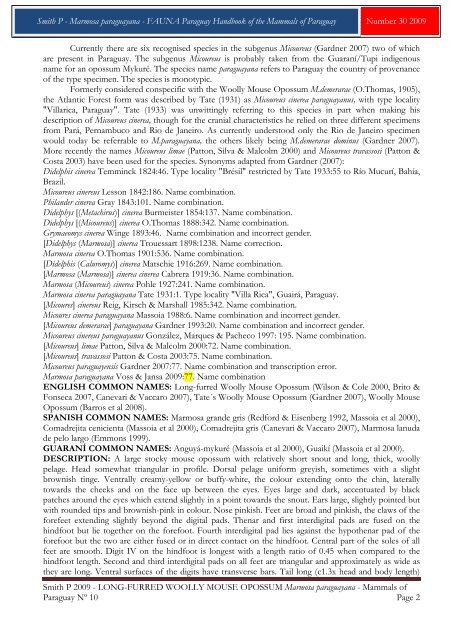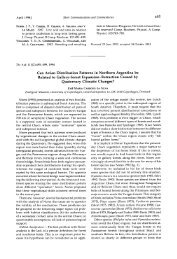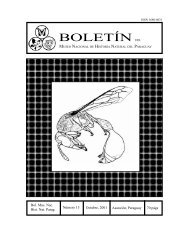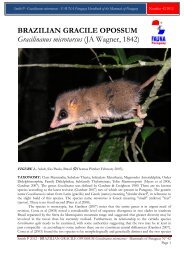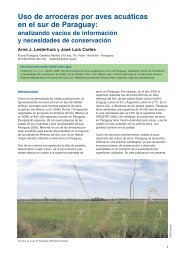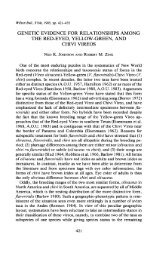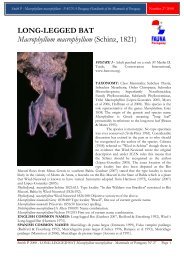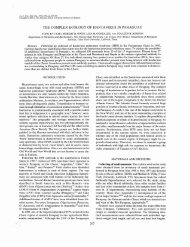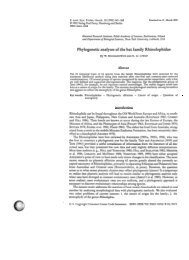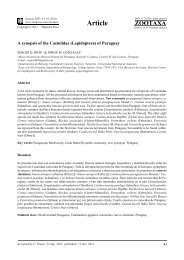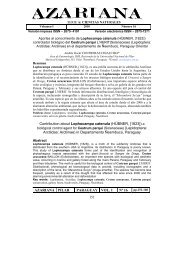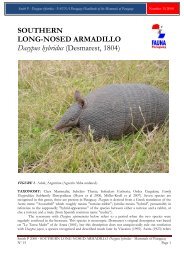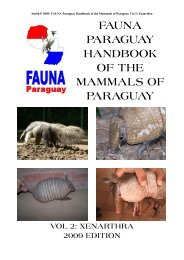Smith P 2009 - FAUNA Paraguay
Smith P 2009 - FAUNA Paraguay
Smith P 2009 - FAUNA Paraguay
Create successful ePaper yourself
Turn your PDF publications into a flip-book with our unique Google optimized e-Paper software.
<strong>Smith</strong> P - Marmosa paraguayana - <strong>FAUNA</strong> <strong>Paraguay</strong> Handbook of the Mammals of <strong>Paraguay</strong> Number 30 <strong>2009</strong><br />
Currently there are six recognised species in the subgenus Micoureus (Gardner 2007) two of which<br />
are present in <strong>Paraguay</strong>. The subgenus Micoureus is probably taken from the Guaraní/Tupi indigenous<br />
name for an opossum Mykuré. The species name paraguayana refers to <strong>Paraguay</strong> the country of provenance<br />
of the type specimen. The species is monotypic.<br />
Formerly considered conspecific with the Woolly Mouse Opossum M.demerarae (O.Thomas, 1905),<br />
the Atlantic Forest form was described by Tate (1931) as Micoureus cinerea paraguayanus, with type locality<br />
"Villarica, <strong>Paraguay</strong>". Tate (1933) was unwittingly referring to this species in part when making his<br />
description of Micoureus cinerea, though for the cranial characteristics he relied on three different specimens<br />
from Pará, Pernambuco and Rio de Janeiro. As currently understood only the Rio de Janeiro specimen<br />
would today be referrable to M.paraguayana, the others likely being M.demerarae dominus (Gardner 2007).<br />
More recently the names Micoureus limae (Patton, Silva & Malcolm 2000) and Micoureus travassosi (Patton &<br />
Costa 2003) have been used for the species. Synonyms adapted from Gardner (2007):<br />
Didelphis cinerea Temminck 1824:46. Type locality "Brésil" restricted by Tate 1933:55 to Río Mucurí, Bahía,<br />
Brazil.<br />
Micoureus cinereus Lesson 1842:186. Name combination.<br />
Philander cinerea Gray 1843:101. Name combination.<br />
Didelphys [(Metachirus)] cinerea Burmeister 1854:137. Name combination.<br />
Didelphys [(Micoureus)] cinerea O.Thomas 1888:342. Name combination.<br />
Grymaeomys cinerea Winge 1893:46. Name combination and incorrect gender.<br />
[Didelphys (Marmosa)] cinerea Trouessart 1898:1238. Name correction.<br />
Marmosa cinerea O.Thomas 1901:536. Name combination.<br />
[Didelphis (Caluromys)] cinerea Matschie 1916:269. Name combination.<br />
[Marmosa (Marmosa)] cinerea cinerea Cabrera 1919:36. Name combination.<br />
Marmosa (Micoureus) cinerea Pohle 1927:241. Name combination.<br />
Marmosa cinerea paraguayana Tate 1931:1. Type locality "Villa Rica", Guairá, <strong>Paraguay</strong>.<br />
[Micoures] cinereus Reig, Kirsch & Marshall 1985:342. Name combination.<br />
Micoures cinerea paraguayana Massoia 1988:6. Name combination and incorrect gender.<br />
[Micoureus demerarae] paraguayana Gardner 1993:20. Name combination and incorrect gender.<br />
Micoureus cinereus paraguayanus González, Marques & Pacheco 1997: 195. Name combination.<br />
[Micoureus] limae Patton, Silva & Malcolm 2000:72. Name combination.<br />
[Micoureus] travassosi Patton & Costa 2003:75. Name combination.<br />
Micoureus paraguayensis Gardner 2007:77. Name combination and transcription error.<br />
Marmosa paraguayana Voss & Jansa <strong>2009</strong>:77. Name combination<br />
ENGLISH COMMON NAMES: Long-furred Woolly Mouse Opossum (Wilson & Cole 2000, Brito &<br />
Fonseca 2007, Canevari & Vaccaro 2007), Tate´s Woolly Mouse Opossum (Gardner 2007), Woolly Mouse<br />
Opossum (Barros et al 2008).<br />
SPANISH COMMON NAMES: Marmosa grande gris (Redford & Eisenberg 1992, Massoia et al 2000),<br />
Comadrejita cenicienta (Massoia et al 2000), Comadrejita gris (Canevari & Vaccaro 2007), Marmosa lanuda<br />
de pelo largo (Emmons 1999).<br />
GUARANÍ COMMON NAMES: Anguyá-mykuré (Massoia et al 2000), Guaikí (Massoia et al 2000).<br />
DESCRIPTION: A large stocky mouse opossum with relatively short snout and long, thick, woolly<br />
pelage. Head somewhat triangular in profile. Dorsal pelage uniform greyish, sometimes with a slight<br />
brownish tinge. Ventrally creamy-yellow or buffy-white, the colour extending onto the chin, laterally<br />
towards the cheeks and on the face up between the eyes. Eyes large and dark, accentuated by black<br />
patches around the eyes which extend slightly in a point towards the snout. Ears large, slightly pointed but<br />
with rounded tips and brownish-pink in colour. Nose pinkish. Feet are broad and pinkish, the claws of the<br />
forefeet extending slightly beyond the digital pads. Thenar and first interdigital pads are fused on the<br />
hindfoot but lie together on the forefoot. Fourth interdigital pad lies against the hypothenar pad of the<br />
forefoot but the two are either fused or in direct contact on the hindfoot. Central part of the soles of all<br />
feet are smooth. Digit IV on the hindfoot is longest with a length ratio of 0.45 when compared to the<br />
hindfoot length. Second and third interdigital pads on all feet are triangular and approximately as wide as<br />
they are long. Ventral surfaces of the digits have transverse bars. Tail long (c1.3x head and body length)<br />
<strong>Smith</strong> P <strong>2009</strong> - LONG-FURRED WOOLLY MOUSE OPOSSUM Marmosa paraguayana - Mammals of<br />
<strong>Paraguay</strong> Nº 10 Page 2


